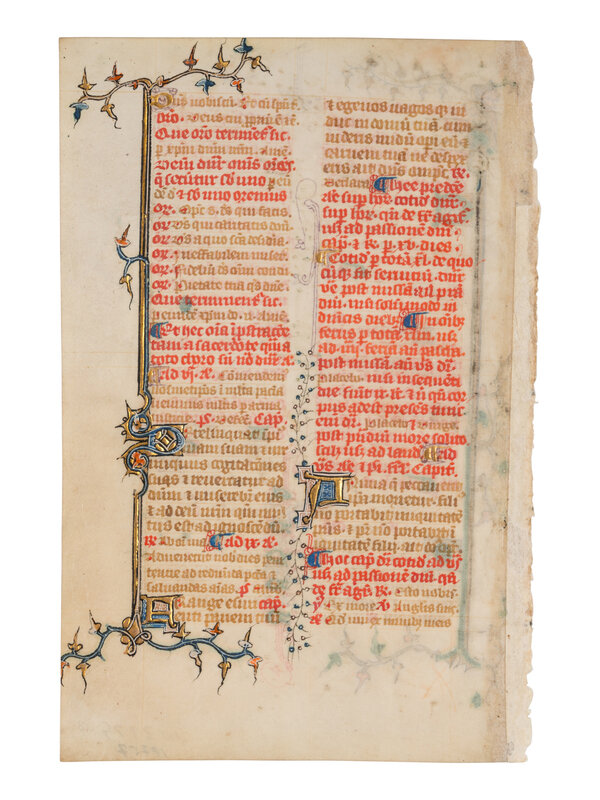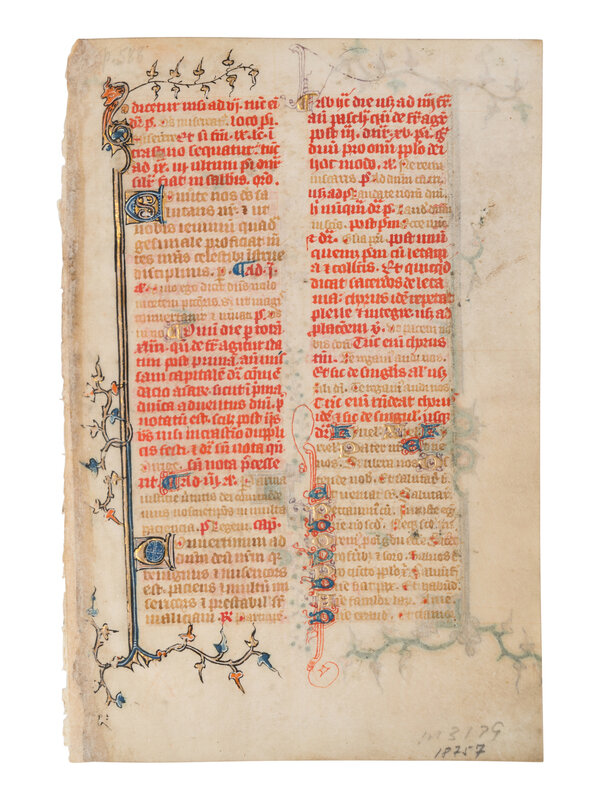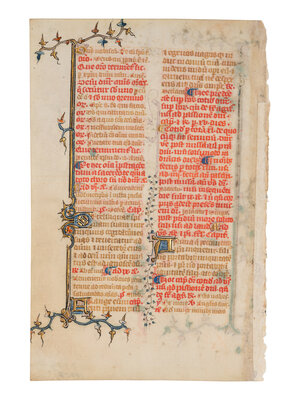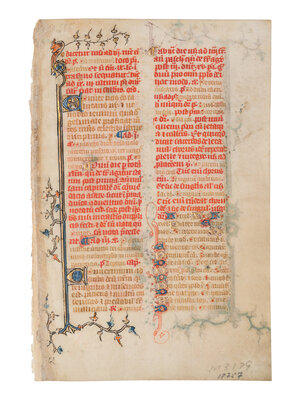Lot 46
ENGLISH ILLUMINATOR
A leaf from an English Breviary, in Latin, illuminated manuscript on parchment [England, c. 1340-1360]
A leaf from an English Breviary, in Latin, illuminated manuscript on parchment [England, c. 1340-1360]
Sale 2033 - Western Manuscripts and Miniatures
Jun 27, 2024
10:00AM CT
Live / Chicago
Own a similar item?
Estimate
$700 -
900
Price Realized
$699
Sold prices are inclusive of Buyer’s Premium
Lot Description
ENGLISH ILLUMINATOR
A leaf from an English Breviary, in Latin, illuminated manuscript on parchment [England, c. 1340-1360]
A leaf from an English Breviary, in Latin, illuminated manuscript on parchment [England, c. 1340-1360]
Elegant leaf from a deluxe English pocket-sized Breviary, unidentified to the present, but one containing over 300 folios.
132 x 86 mm. Single leaf, modern pagination “p. 588” in pencil in the lower left corner of the verso, ruled in light brown ink for two columns of 35 lines (written space: 97 x 56 mm), written in light brown ink in a gothic bookhand, rubrics in red, capitals touched with red, one-line initials in in blue on red penwork or in burnished gold on violet penwork, five two-lines illuminated initials alternately in burnished gold on red and blue ground, or blue on burnished gold ground, with white tracery, extending into a burnished gold and colored bar border enclosing of the full height of the left column, terminating in swirling ends of ivyleaves in the upper and lower margins, including a hybrid on the top corner of the recto (parchment repair along the sewing edge, taped paper on the upper right corner of the recto, lower scroll of the verso slightly trimmed, else in good condition).
This small leaf, with subtle penwork decoration and two long bar borders, comes from an as-yet unidentified pocket-sized Breviary, of likely English origin. Breviaries are among the most important liturgical manuscripts surviving from the Middle Ages and gather all the sung and spoken portions of the Divine Office. This leaf comes from a section gathering liturgical directions for the daily offices to be held during the period of Lent according to the use of Sarum. The text reads from the prescription for Lauds on the recto, “dicetur, nisi ad Sextam,” to the antiphon for Vespers, “Quod uni ex minimis meis”.
The elegant penwork decoration of the script suggests that the parent manuscript would have been copied and illuminated in England in the middle of the fourteenth century. This is supported by the full-height bar borders developed in the left margins, which are reminiscent of another pocket-sized Sarum Breviary at the Baillieu Library in Melbourne, illuminated in the 1340s, distinguished by the use of a vivid orange and by rather simple ivy leaves (see Manion and Vines 1984, no. 43; Michael and Morgan 1993). The quality of the burnished gold bears witness to the luxurious nature of the parent manuscript, which would have comprised at least three hundred leaves based on the modern pagination.
Provenance:
(1) Charles Edwin Puckett, his IM-3179, as written in pencil in the lower margin of the recto.
(2) Private collection, California, USA, MS 234.
LITERATURE
Further literature, see Margaret M. Manion and Vera F. Vines, Medieval and Renaissance Manuscripts in Australian Collections, London, 1984, no. 43; Michael A. Michael & Nigel Morgan, “The Sarum Breviary in the Baillieu and Bodleian Libraries,” La Trobe Journal 51-52 (1993).
Freeman’s | Hindman thank Senior Consultant Sandra Hindman and Elliott Adam for their assistance in preparing this sale.
Property of a Private California Collector
Condition Report
Contact Information



